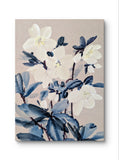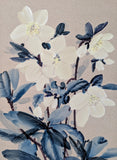Hellebores on a Winter's Walk II by Shilpa Agashe
Title: Hellebores on a Winter's Walk II
Artist: Shilpa Agashe
Medium: ink and watercolour on heavyweight recycled paper
Size: 22 cm x 30 cm (unframed)
Shilpa Agashe (b. 1979) is an artist living in London, practicing chinese brush painting. Having spent part of her career working in Tokyo, Japan, as a computer engineer in the banking sector, she is drawn to brush painting as both a philosophy and artform. She is currently studying Chinese Brush Painting at Hampstead School of Art.
"The works I have submitted for this open call depict flowers that bloom in winter—Hellebores and Snowdrops. These delicate yet resilient blooms punctuate the tedium of grey winter walks, acting as signposts, guiding us through the longing and waiting for a new beginning which John Berger mentions in his letter.
"Berger admired the Zapatistas for their ability to resist not only through their armed struggle but also through poetic and symbolic gestures. In some ways, these winter flowers also reflect a defiance, albeit quiet, against the harsh conditions of winter. On the surface, Hellebroes and Snowdrops symbolise hope, resilience, and the quiet tenacity to endure winter. Yet, beneath their gently bowed forms lies a more complex narrative. Both plants are toxic, their poison an unseen form of defense ensuring survival in winter. This clandestine nature is analogous to the secrecy of any organised resistance.
"The restrained palette and compositions in these paintings capture the cold, breathless delight of seeing these flowers in bloom on a winter’s walk but also allude to a sense of unease. The quiet beauty of snowdrops and hellebores is tinged with something unsettling: their bowed heads, as if in mourning, their presence once considered an omen of death, and their toxicity, hidden beneath fragile petals. They persist in the depths of winter, thriving when most other life is dormant, defying expectations of fragility. This contradiction—a flower that signals both resilience and danger, renewal and death—creates a moment of tension much like the resistance Berger describes.
"As he writes in his letter, “Nothing alarming. Rather something measured and solemn.” The presence of these winter flowers, like the slow beat of the heron’s wings, speaks of
endurance, of a quiet but unwavering survival."




